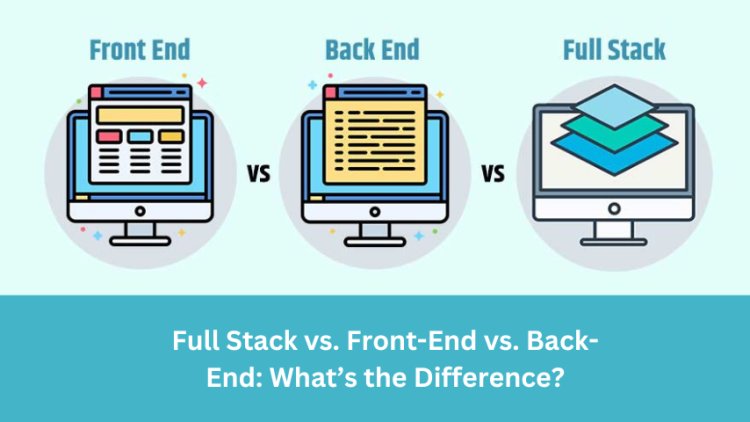In the web development, the terms Full Stack, Front-End, and Back-End are frequently used, but what exactly do they mean? Understanding the differences between these three areas is crucial for anyone who is entering the field of web development, whether you're aiming to specialize or you're simply curious about the technologies behind modern websites and applications.
Let’s break down the key differences between Full Stack, Front-End, and Back-End development, the roles they play, and how they work together to build seamless digital experiences.
What is Front-End Development?
Front-End development refers to everything that users interact with directly in their web browser. It’s the “face” of a website or application. Front-End developers are responsible for creating the layout, design, structure, and behavior of a website's user interface (UI). Essentially, Front-End development is about making websites look good, feel intuitive, and work smoothly for users.
Key Skills & Technologies in Front-End:
- HTML (HyperText Markup Language): The structure of web pages.
- CSS (Cascading Style Sheets): The styling and layout of web pages.
- JavaScript: Adds interactivity and dynamic content to a webpage.
- Frameworks/Libraries: Tools like React, Angular, Vue.js, and Sass help speed up development and create rich user interfaces.
Front-End Developer’s Role:
- Creating responsive web designs that work on various devices.
- Ensuring website performance, speed, and user experience.
- Integrating with APIs and the back-end to display dynamic data.
What is Back-End Development?
Back-End development involves the server-side of a web application. This is where the logic, database management, and data processing happen. Back-End developers focus on making sure that everything the user interacts with on the front-end works properly behind the scenes. The back-end is responsible for handling the requests made by the user’s browser, interacting with databases, and returning data in a usable format.
Key Skills & Technologies in Back-End:
- Server-Side Languages: Python, Ruby, Java, PHP, Node.js, etc.
- Databases: SQL (Structured Query Language) and NoSQL (such as MongoDB) for storing data.
- Server Management: Web servers like Apache or Nginx, and understanding cloud services such as AWS and Azure.
- APIs: Application Programming Interfaces (APIs) to allow communication between the front-end and back-end.
Back-End Developer’s Role:
- Writing server-side logic and algorithms.
- Managing databases and ensuring data integrity.
- Creating APIs that allow the front-end to interact with the data stored on the server.
What is Full Stack Development?
Full Stack development encompasses both Front-End and Back-End development. Full Stack developers are skilled in both the user-facing and server-side aspects of web development, enabling them to build complete, end-to-end web applications.
A Full Stack developer has the flexibility to work on both the Front-End and the Back-End, often switching between them as necessary to create seamless user experiences. They have a broad skill set that covers a variety of technologies and frameworks, making them incredibly versatile.
Key Skills & Technologies in Full Stack:
- Proficiency in both Front-End and Back-End technologies.
- Knowledge of version control tools like Git.
- Understanding of databases (both relational and non-relational).
- Familiarity with frameworks such as React (Front-End) and Node.js (Back-End).
- Ability to work with cloud services and deployment tools like Docker and Kubernetes.
Full Stack Developer’s Role:
- Designing and implementing the entire architecture of a web application.
- Building both the Front-End and Back-End, ensuring that they work seamlessly together.
- Handling the full life cycle of a web application, from planning to deployment.
Key Differences Between Full Stack, Front-End, and Back-End
-
Focus Area:
- Front-End: Focuses on the user interface and experience.
- Back-End: Focuses on the server-side logic, database management, and application functionality.
- Full Stack: Covers both the front-end and back-end, offering a holistic view of web development.
-
Skills and Technologies:
- Front-End developers use languages like HTML, CSS, JavaScript, and frameworks like React and Angular.
- Back-End developers work with server-side programming languages (Python, Java, Node.js) and manage databases (SQL, NoSQL).
- Full Stack developers need to be proficient in both front-end and back-end technologies, plus some extra skills like cloud computing and version control.
-
Role in the Development Process:
- Front-End developers are responsible for what users see and interact with.
- Back-End developers handle the server-side and databases to make sure everything works behind the scenes.
- Full Stack developers handle the entire process, from designing the user interface to ensuring the server and database are functioning.
-
Complexity and Scope:
- Front-End and Back-End developers typically specialize in one area.
- Full Stack developers need to have knowledge of both, making their role more comprehensive and versatile.
Why Choose Full Stack Development?
For many businesses, hiring Full Stack developers is a practical choice because they can handle both the front-end and back-end, providing more flexibility and faster development cycles. Full Stack developers are especially valuable in smaller teams or startups where resources are limited, and having a developer who can manage both aspects of the application is a huge advantage.
On the other hand, Front-End and Back-End specialists are invaluable in larger projects where the complexity and scale require specialized expertise. Many large tech companies or high-traffic websites require teams of front-end and back-end developers to focus on optimizing performance, usability, and scalability.
Conclusion
So, what’s the difference between Full Stack, Front-End, and Back-End development? It comes down to scope and specialization. Front-End developers focus on the user interface and user experience, Back-End developers work behind the scenes to ensure everything runs smoothly, and Full Stack developers have the flexibility to handle both aspects of the development process.







